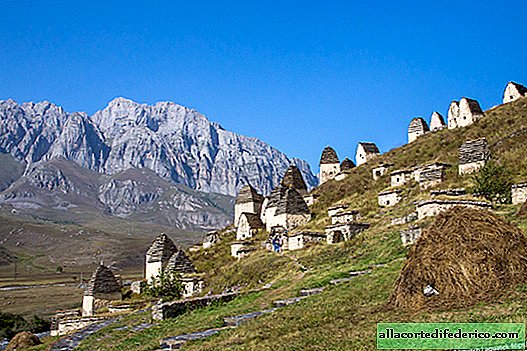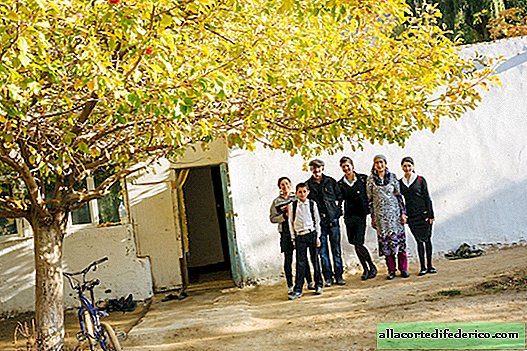Dargavs - the city of the dead in Ossetia
Surely something, but you will not see dead bodies in every journey.
And not some tourist props, but the real half-decayed remains of people. And all this, you will not believe in Russia!
Of course, I have been to the necropolises and the so-called "cities of the dead" in the Caucasus before, but everywhere these were long empty crypts.
Dargavs in North Ossetia is a completely different matter. This is one of the few surviving "cities of the dead" where you can fully feel the atmosphere of death soaring in these cold crypts, just because of the still decomposed and mummified bodies that are still here ...
The area where Dargavs is located has been inhabited since the Bronze Age. A large number of archaeological sites have been discovered here, including the Alanian burial ground of the late 1st millennium BC. e. According to legend, Tsarevich Taga lived here, the ancestor of the clans and surnames of the upper class of East Ossetia.
Dargavs in the past was the center and largest settlement of East Ossetia - Tagauria. Therefore, the most significant crypt burial ground in the North Caucasus grew up on the Gizeldon shore, and in many ways surpassed the "city of the dead" near the village of Verkhnyaya Balkaria (Kabardino-Balkaria) and the Chechen necropolis of Tsoi-Pede.

From Mount Raminyrakh, from the place where the necropolis is located, a view of extraordinary beauty opens up. On the southern side of the gorge rises the icy peak of Mount Dzhimaray-Khokh. At the bottom of the river runs Gizeldon. There are also the ruins of the abandoned village of Hussar Khintsag, over which two generic stone towers rise.

The battle tower is an integral part of the Ossetian culture of the past. The construction of such towers could only afford the richest surnames.

The architectural ensemble of the most grandiose “city of the dead” in the North Caucasus consists of 95 structures. All tombs are divided into three types.

Some crypts are located above the ground, and their roof is a stepped pyramid, assembled from rectangular slate tiles. This tile was chipped off the rocky surface, and after simple processing, it turned into a kind of durable waterproof tile. Another type of tombs is the same crypts, but crowned with a gable slope. The third, most unpretentious constructions, are half located underground and are rectangular chambers made of large, roughly processed stone slabs.

When constructing the crypts of the Dargavsky Gorge, the same building techniques were used as when creating defensive structures, taking into account local building traditions. But what confuses scientists is the similarity of Ossetian crypts with a pyramidal-stepped overlap with the towers of the famous temples of Angkor in Cambodia. Until this riddle is solved.

Semi-underground crypts are the most uncomplicated in design and unassuming. Rectangular chambers are composed of large, roughly processed slabs and stones; walls at a height of about one and a half meters begin to turn into a false vault, characteristic of mountain Caucasian construction. Grooves were made in the longitudinal walls, into which wooden beams were inserted. Plank flooring was laid on them. Through the narrow square hole in the front wall, the dead were brought in and laid on the floor. Then the hole was closed with a wooden door with a bolt.

Obviously, over the years, crypts have become a tomb for several generations of people belonging to the same family. Some structures have two or even three tiers. When there was no free space inside, the mountaineers made additional flooring, for this they punched grooves in the walls and inserted wooden beams into them, on which boards were then laid.

The crypts of Ossetia have not been studied for a long time. Before the revolution, this was ruled out - anyone who dared to penetrate the crypt could pay for it with his life. But later, until 1967, archaeological work on the study of these most valuable monuments was almost not conducted. The "bad reputation" of the crypts also played a well-known role.
Today in Ossetia, one can still hear traditional stories that in the old days in the mountains a plague epidemic raged, claiming thousands of lives. In order not to infect their neighbors, patients with entire families, with children in their arms, went to pre-built crypts, where they died. Those who remained healthy left the gorge.
Epidemics in the mountains of pre-revolutionary Ossetia really happened. As a result of the plague that raged in the late XVIII - the first half of the XIX century, the country's population from 200 thousand people was reduced to 16 thousand. Ossetians were then on the verge of extinction.

In the study of burials, many different objects were found that belong to different historical eras. The most amazing of them are “boats”. In many burials, the remains lay in decks hollowed out of wood, which in their appearance resembled a boat, a boat. Burial in a boat is a fact not noted among neighboring peoples. Rooks were found in Dargavs more than once, and about one of them was even laid ... an oar! Why is it in the mountains, where the largest river flows are absolutely non-navigable? Involuntarily, I recall the mythical river of the underground kingdom Styx, through which the carrier Charon crosses the souls of the dead on a boat.

The place where several generations of highlanders have found rest, residents of Dargavs try to avoid. Villagers appear here only during daylight hours to mow grasses. Why do the bold highlanders cautiously glance towards Raminyrakh? Since ancient times, in the Dargavsky gorge there is a belief: anyone who dares to venture into the crypt out of idle curiosity will pay for it with his life.

On the other side of the valley you can see another "dead town" belonging to the abandoned village of Hussar Hinzag. A little further one more, and more ...
There are many tombs on the territory of the republic: somewhere, one or two tombs, somewhere more, and somewhere whole "settlements". Near almost every mountain settlement of Ossetians, several crypts were built, sometimes they formed in necropolises. Usually they were built on the outskirts, at a short distance from each other, but often they were scattered throughout the settlement, adjacent to almost every house.
Here are just a few solitary tombs that I met on the way to the Dargavsky Gorge.

The archaic traditions of the cult of the dead have been preserved among Ossetians for a very long time. Only in the 30s of the XIX century, when they began to move from the mountains to the foothill plain, only then burials in crypts were stopped.

Dargavs reliably keeps his secrets, and scientists, continuing to search and excavate, hope to someday solve them.


















